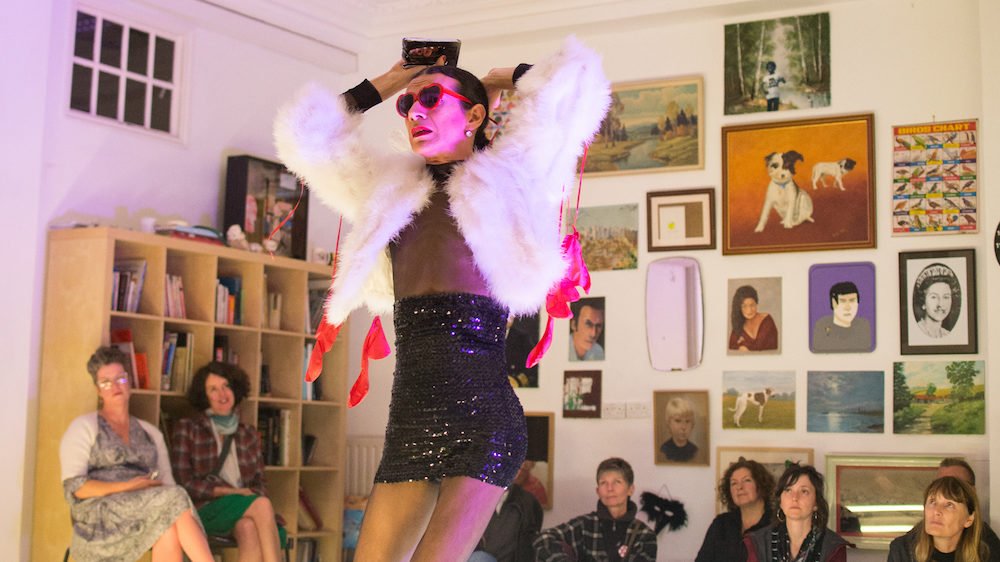Emily Humphreys on Nando Messias
Coastal Undercurrents is a writing initiative supporting six local writers to produce written responses to live work experienced during the Home Live Art programme of performance at Coastal Currents 2018 in Hastings.
Emily Humphreys responds to the work of Nando Messias
I’d have a lot to say about every artist I saw at this richly immersive event, but in particular I was moved by the work of Nando Messias, a Brazilian artist based in London. Messias’ piece was captivating from the off. He appeared shyly but was stunningly dressed in tight fitting black, with stiletto heels and a white fur jacket all contributing to the show. He wanted our eyes and he had them. He began by lip-syncing to a spoken recording and I wondered whether the artist was using their own words. His gesticulation towards us was somehow both perfect for the voice and yet wildly extravagant at the same time.
The speaker was not Messias though but Judith Butler, perhaps our best contemporary philosopher on the social construction of gender identity, but also of the discursive frameworks we rely on to make sense of sex itself – like biology. She shows why the body does not dictate our gender, that perhaps it is the other way around, perhaps the truth is that nobody has the power to decide what gender they are.
The segment of Butler’s speech Messias chose to employ gives an account of a young man who was murdered, growing up in his home town, because his walk was too feminine. Walking a certain way should not impose a binary gender identification upon us, no more than a sex category should impose a behaviour upon us, be it washing dishes or mining coal.
As social beings, human are never able to get beyond social influence entirely. I feel we are just about on the same page accepting this idea: that we are influenced by parents, teachers, friends and wider society. Few deny that the materiality of the body has real effects and interacts with culture. But a great many cis-gendered folks still believe their gender expression and sexuality are embodied features of a real self: aligned by nature and by design. Do we degrade and dismiss non-conformers because we cannot afford to admit our own identities are not natural? Whatever freedoms we might win, if we were to confront the sedimented training we have been built from, can we ever know in advance whether they are worth the loss of who we are now?
The specific power of Messias’ finessed, animated performance of Butler’s speech is to give the audience a window through which to see the dead boy as a real person. The injustice is painfully close, the violent crime is comfortably distant … though in a wordless display using the fur, bright red balloons and the art of noise, Messias will bring it as close as he can. Of course we ‘know’ the boy is real, but Messias invites us in a deeper way, to see that the boy walked like this, to fully grasp that he died just for this. As Butler asks: why would someone find the way this boy walked so troubling, that they would need to deal with that feeling by putting him to death?
Were the boys who killed him afraid of their own inner worlds? Were they threatened by the very existence of a boy who did not display correct masculinity? Is there a set of compulsory behaviours which those boys could never escape, for fear of how they would be punished?
Cis-men might claim that they are naturally-masculine in these ways, and untold numbers of badly written books and badly designed science will reaffirm their assertions. Who sees that normal-masculinity is just as much a performance as high heels and lipstick? That club the normal boys belong to varies in every town, city and country, but wherever bravado plays a role in policing its membership and boundaries – keeping that which might be feminine firmly outside – that desire for point scoring combines lethally with that universal mute fear of losing status.
In challenging an audience to sit with this one death, Messias can raise questions without providing the answers, as great art so often will. Here he gave us Butler’s question whole. He conveys violence in a way which is both powerful and surprisingly gentle, as if devoid of anger. This generosity frees us from our typical defensiveness: we simply know the thing is wrong.
Emily Humphreys is a writer, poet and amateur philosopher living in Brighton. She writes creative and straight nonfiction about gender, sex, relationships and cultural politics.
Nando Messias performed this work at the first Hastings Performance Salon on Friday 28 September 2018.
Coastal Undercurrents is the first initiative of Home Live Writing, an ongoing project for writers based in the south east who wish to learn more about writing critical responses to live performance.
All images photographed By Georgina Cook.




